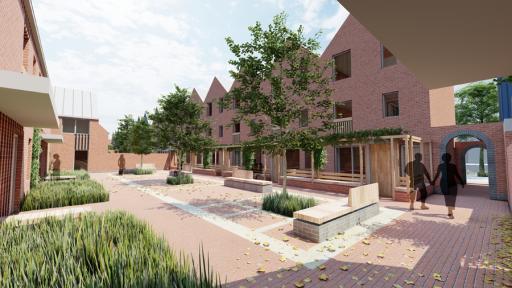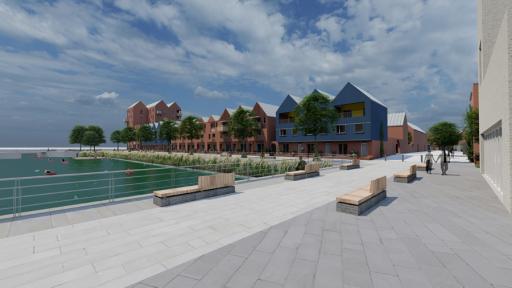Designs for the remaining phases of Trent Basin, the emerging neighbourhood beside the River Trent in Nottingham, have been revealed at planning by Proctor and Matthews Architects – also the masterplanner for this phase of the project – alongside Sarah Wigglesworth Architects and Turner Works Architects.
Phases 4-8 of the Trent Basin masterplan will build on the success of the first phases of the project, of which two are now complete with one currently under construction. The 3ha site will deliver 300 contemporary low carbon homes in total, connecting green sustainable living in the city with Nottingham’s unique riverside character, while employing the very best in new construction technologies. The project is by developer Blueprint, a specialist in sustainable homes managed by igloo Regeneration.
This final phase of the project comprises of 111 homes, with each of the three architecture practices interpreting Nottingham’s context in a unique way to provide a townscape rich in architectural variety. Trent Basin lies at the eastern edge of Nottingham’s wider Waterside Regeneration Zone and is a pivotal site within the wider waterside regeneration area, with a significant historic wharf at the heart of the development.
The differing house types proposed for the final phases of the development include taller terraced typologies to provide strong frontages to both the basin and the riverfront, apartment villas to provide significant townscape markers, four-storey maisonette buildings to line the triangular neighbourhood park, and three-storey terraced houses to run along the outer edge of the site. This range of different-sized maisonettes and family homes will help support a mixed neighbourhood of first-time buyers, families, and downsizers.Utilising modern methods of construction to meet Blueprint’s advanced sustainable targets, all the homes incorporate spaces to meet modern day needs, including contemporary living and kitchen spaces connected to gardens, generous storage, and dedicated home working stations.
A shared palette of materials, including red brick and corrugated cladding, will be used across the masterplan, with accent materials that reference Trent Basin’s historic dockside activity. To bring variety to the project, all three practices involved in this phase of the project will be interpreting the context of the wider Nottingham area and the specifics of Trent Basin in different ways.
In support of the scheme’s wider transport strategy, this phase of the masterplan aims to reduce the dominance of vehicles and make streets into social and pedestrian friendly environments. A sequence of residential courtyards, arranged and connected via semi-private
pedestrian routes, are to provide a safe place for social gatherings, children’s’ play and neighbourly interaction.
The masterplan will support the singular east to west route for vehicles, while enhancing the new pedestrian riverfront path with a generous promenade running along the western side of the basin, leading to a public square, and connecting with the wider riverside cycling and walking routes. It will also include a pedestrian bridge connecting the two sides of the basin neck. Electric vehicle charging locations will be provided across the site.
The triangular neighbourhood park at the head of the basin will be a focal point for this phase of the masterplan, including a public park, playground and public square with trees and seating. The central car-free, pedestrian and cyclist-friendly green space will also be home to the e-mobility hub, which will provide a centralised location for community activity, as well as creating a public focus and space at the head of the basin.
A former industrial space within the square will form a Makers Yard; a spill-out area for the new workshops that will occupy the industrial units to the eastern and western sides of the site, also designed to become an active urban hub for creative activities, events and market stalls.
Andrew Matthews, commented: ‘The design for Trent Basin focusses on creating a new riverside community that is well connected and walkable, with shared spaces for meeting neighbours and sustainable new homes that work towards Nottingham’s Carbon Zero ambitions. Housing is arranged in sheltered courtyards while the extensive people friendly public realm that stitches the development together is made possible by the introduction of a car barn allowing the streets and spaces to become the focus of community life.’













